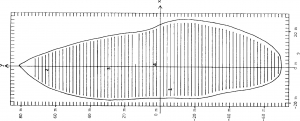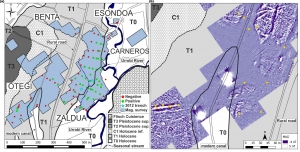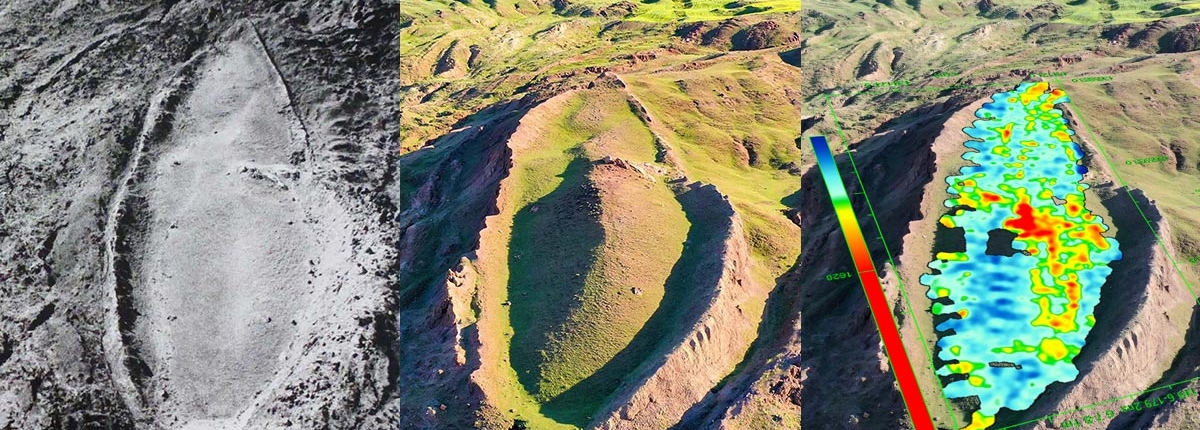*Click each question or plus + symbol to expand to see the answer
Why are ground-penetrating radar (GPR) and electrical resistivity tomography (ERT) scans being done? I thought these were done before?
It is true that in the past private groups in the 1980s and then again in, 2010, 2014 and 2019 have performed geophysical surveys of the Noah’s ark site but the Turkish scientists involved in this current effort either do not have access to the past surveys’ raw data or not all of the surveys were completed. On top of that, the Turkish scientists want to obtain their own data first hand. Plus they have asked us to help scan a number of other sites in the area that they are working on.
When will the Noah’s ark excavations start? How can I volunteer?
Excavations will only happen after the geophysical surveys (which include new GPR and ERT scans) are finished and the core drilling is done. The Turkish scientists are very methodical with their plans and do not want a destructive pit dug on the boat formation before core drilling can determine hopefully what some of the layers are that we see in the geophysical survey results done in the past. We are taking this one step at a time with them and the focus right now is to get the geophysical surveys and core drilling finished.
We are still working through how volunteers can be used for the project. We have discussed this with the Turkish archaeologists and will announce in the future what has been decided. We do know that East Turkey Expedition’s tours will have exclusive tours of the sites with access to the professionals involved so that those on the tours can see the work being done and ask questions. Discovered Media and its Turkish partners will also have exclusive media rights to the excavation details for specific areas of the world and will be able to present these exciting discoveries thanks to your generous financial support and prayers!
We are allowing volunteers to help with the new multimedia Visitor Center expansion project and the new hiking trails project around the boat formation. You can sign up as a volunteer on this website by clicking here.
Why is core drilling being done? Why can’t we just excavate the ark finally?
Archaeology is a destructive science. Once you dig a hole and remove material you can’t put it back. Having the best data as to where to excavate is key and that is where geophysical scans and core drilling come into play. The core drilling will hopefully tell us about the layers under the ground that are showing up in the geophysical survey scans and the drilling would only involve a 3 inch to 4 inch size core hole versus a 5 meter square pit dug into the boat formation. Excavations would follow after this is done.
But didn’t Dr. John Baumgardner and Dr. Salih Bayraktutan already do core drilling on this site?

“In 1988 we finally obtained permission to drill into the site, and we obtained reasonably good quality core from four different holes.” (Baumgardner, 1999 email)
Between July 28 and August 7, 1988 team from Turkey and the US did drill at the Durupinar Noah’s ark boat formation site. However, the team only drilled four 3 ½ inch diameter holes of which only three reached any significant layers and depths. While Dr. Baumgardner wrote that they found nothing man-made or any petrified wood he also stated that his three core holes on this 515-foot large boat formation site were “severely limited in its ability to find buried archaeological structure, especially if it is sparsely distributed and has been significantly altered by decay and chemical weathering.” (Baumgardner, August 1988) To learn more about their core drilling please click here.
While Dr. Baumgardner, who is a geophysicist, in the end decided that this site was not Noah’s ark his Turkish colleague and partner in the 1987 geophysical survey expedition and their 1988 core drilling work, Dr. Salih Bayraktutan, still maintains that “We have a boat-shaped object at an elevation of 2,000 meters that did not occur naturally. We haven’t found anything that refutes the possibility of this being Noah’s Ark. We can see signs of specific structures in our scannings that are not naturally occurring.” (Bayraktutan, September 2002)
As the Wyatts have stated in their newsletter, “Taking 4 core specimens of 3 ½ inch diameters from a site 515 feet long does not provide a fair representation of material present. And even with this minute amount of specimen, evidence was found of an extremely high iron content, including limonite.” (Wyatt Archaeological Research Newsletter, July 1996)
To learn more about core drilling as a tool in archaeological sites please review this paper, Geoarchaeological Core Prospection as a Tool to Validate Archaeological Interpretation Based on Geophysical Data at the Roman Settlement of Auritz/Burguete and Aurizberri/Espinal (Navarre). (Geosciences, October 2017) “This paper analyses the validity of geoarchaeological core survey to check the archaeological interpretations based on geophysical results… Site delimitation and archaeological interpretations based on magnetic data could be improved or corrected. In this regard, the core survey proved to be a useful methodology as many anomalies could be checked within reasonable time and resources. However, further geophysical investigations through GPR revealed unexpected remains in areas where no archaeological deposits were identified through coring. Excavations showed poor conservation level in some of those areas, leading to thin archaeological deposits hard to identify at the cores. The sediment core survey, therefore, was proved to be inconclusive to delimit the archaeological site.”

Figure 3. (a) Location of the cores drilled in 2014 over the geological plan and areas of the magnetic survey (T: Terrace; C: Colluvium). The cores showing archaeological deposits are highlighted as positives, and the ones where no archaeological remains were identified as negatives. (b) Location of the cores drilled in Otegi area in 2016, over the magnetic response map.
Is it true that the Turks took over the excavation project and kicked out the Americans?
First, it is a fact that the Durupinar Noah’s ark site is in the country of Turkey. It is also a fact that it would be a national treasure if fully proven and accepted by the scientific community. It is also a fact that any excavation in the country of Turkey would require professional fully qualified Turkish professors of archaeology to do a legal excavation that would be accepted by the government and the scientific community. Those are facts. To assume that foreign lay people could come in and do their own private excavation is a fantasy and would be illegal too. Now with that said the Turks involved with this new research into the Durupinar Noah’s ark site have asked Discovered Media and others for help in specific areas of their project and have taken advice from us about which areas could provide the best results during an excavation or geophysical survey, etc. So in this regard it is a team effort. The Turks rightly are in charge but are also smart to work with those who have studied the site over the years and have knowledge of previous private survey work done at the site.
Is it true that the Turks are trying to "write Ron Wyatt‘s name out of the Noah’s ark story?"
Recently some individuals from the United States have been claiming in private messages and in a YouTube interview that the Turks are trying to “write Ron Wyatt’s name out of the Noah’s ark discovery” (not an exact quote). This type of misinformation attacking the Turkish efforts to promote Noah’s ark has consequences and sadly this is being publicly spread around by individuals who should know better. Are the Turkish authorities really trying to remove Ron Wyatt’s past efforts from the story of the Durupinar site? Absolutely not! There has been no evidence presented to support this type of unwarranted attack. The Turks have put forth various marketing efforts for the Durupinar Noah’s ark site using different books, press releases and even a documentary film about the initial discovery and early 1960s efforts to promote the site by the Turks who discovered the site. Telling the story of the 1960s events in no way is an attempt to belittle or remove Ron’s 1970s-1990s efforts at the site. In fact, a recent Turkish book about the Durupinar ark site mentions the later work done by Ron Wyatt, David Fasold, Dr. Salih Bayraktutan and Dr. John Baumgardner. This book was later edited by Discovered Media and some of the data about Ron Wyatt in the book was fixed in the English edition. A whole new chapter about the 2014 resistivity (ERT) scans was also added in thus introducing the survey results to a Turkish audience. This chapter’s text and graphics were mainly taken from a public website and reports submitted to the Turkish government.
I saw online that a team from another country is also trying to excavate the Durupinar Noah‘s ark site. Why isn’t everyone working together on this?
It is true there were possibly 2 or 3 other groups at different times in the past 10 years and more recently who were/are trying to get permits to excavate the Durupinar ark site and even Ron Wyatt last attempted to excavate the boat formation in the 1990s. Our group’s current efforts at the site started right after the October 2014 resistivity survey expedition, Andrew Jones talked to his long-time local friend and guide, Zafer Onay, about doing more work on the site. Ultimately this lead to efforts to try to get permits to excavate the site in the summer of 2015 but due to instability in the region that summer no excavation was started and in 2016 the coup attempt stopped that year’s efforts to excavate the site. The country of Turkey was under a state of emergency until the summer of 2018. In the fall of 2018 and in the summer of 2019 we met Turkish scientists willing to work with us. In 2020 everything came to a stop due to the pandemic. Each group attempting to do work in this region has its own guides, contacts, interests and goals. While it would be nice if all the resources were pooled together to do a joint effort so far for different reasons this has not been possible. Maybe in the future things will change. For now, we feel our work directly under the Turkish scientists is the best bet to finally making an excavation happen.
Ron Wyatt discovered Noah’s ark! Why are you stealing his discovery?
Sadly this is an all too often accusation by ill-informed individuals when we bring up the new scientific work being planned for the Durupinar ark site. First, how does one “steal” the Noah’s ark discovery by doing all this hard work in trying to further prove it and gather more scientific data? You can’t! Trying to prove his claims about the ark site with more scientific data gathered with newer technologies in no way harms the memory of his efforts done on the site in the 1970s-1990s or take away any credit due to him for promoting the site as Noah’s ark back then. In fact, if the new data proves it’s a boat there then Ron’s past efforts will never be forgotten.
Second, some individuals who love to stir up dissent, disunity and strife and create drama with rumors and email campaigns behind the scenes are only hurting the actual research into the Noah’s ark site. They have little to show for their efforts except for division among the researchers. Ignore the bad and focus on the good!
Third, Andrew Jones with Discovered Media and one of the sponsors of this current effort used to talk to Ron Wyatt on the phone while a kid in the early 1990s and met him a few times. He is in no way trying to steal any credit from anyone and has fond memories of his many long phone calls with Ron talking about Biblical archaeology and history. Ron is sorely missed.

